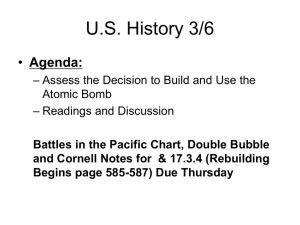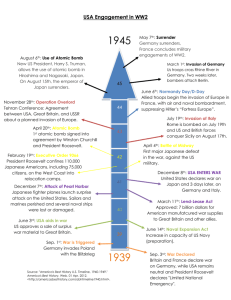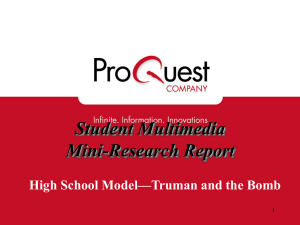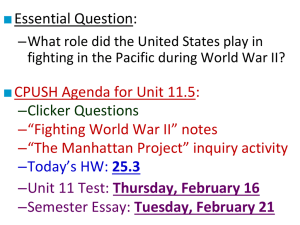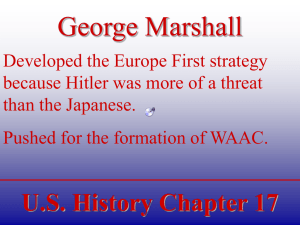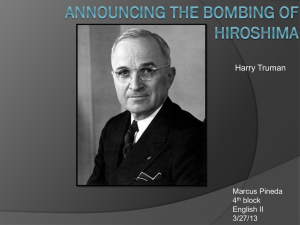Arguments Against and For The Bomb
advertisement
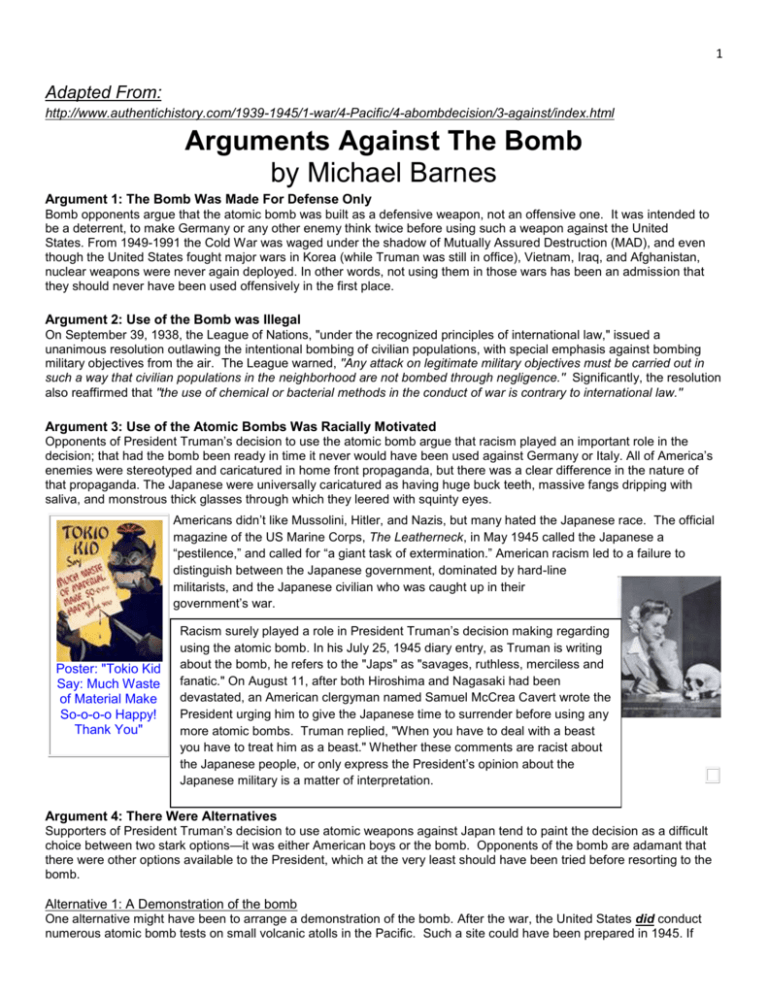
1 Adapted From: http://www.authentichistory.com/1939-1945/1-war/4-Pacific/4-abombdecision/3-against/index.html Arguments Against The Bomb by Michael Barnes Argument 1: The Bomb Was Made For Defense Only Bomb opponents argue that the atomic bomb was built as a defensive weapon, not an offensive one. It was intended to be a deterrent, to make Germany or any other enemy think twice before using such a weapon against the United States. From 1949-1991 the Cold War was waged under the shadow of Mutually Assured Destruction (MAD), and even though the United States fought major wars in Korea (while Truman was still in office), Vietnam, Iraq, and Afghanistan, nuclear weapons were never again deployed. In other words, not using them in those wars has been an admission that they should never have been used offensively in the first place. Argument 2: Use of the Bomb was Illegal On September 39, 1938, the League of Nations, "under the recognized principles of international law," issued a unanimous resolution outlawing the intentional bombing of civilian populations, with special emphasis against bombing military objectives from the air. The League warned, "Any attack on legitimate military objectives must be carried out in such a way that civilian populations in the neighborhood are not bombed through negligence." Significantly, the resolution also reaffirmed that "the use of chemical or bacterial methods in the conduct of war is contrary to international law." Argument 3: Use of the Atomic Bombs Was Racially Motivated Opponents of President Truman’s decision to use the atomic bomb argue that racism played an important role in the decision; that had the bomb been ready in time it never would have been used against Germany or Italy. All of America’s enemies were stereotyped and caricatured in home front propaganda, but there was a clear difference in the nature of that propaganda. The Japanese were universally caricatured as having huge buck teeth, massive fangs dripping with saliva, and monstrous thick glasses through which they leered with squinty eyes. Americans didn’t like Mussolini, Hitler, and Nazis, but many hated the Japanese race. The official magazine of the US Marine Corps, The Leatherneck, in May 1945 called the Japanese a “pestilence,” and called for “a giant task of extermination.” American racism led to a failure to distinguish between the Japanese government, dominated by hard-line militarists, and the Japanese civilian who was caught up in their government’s war. Poster: "Tokio Kid Say: Much Waste of Material Make So-o-o-o Happy! Thank You" Racism surely played a role in President Truman’s decision making regarding using the atomic bomb. In his July 25, 1945 diary entry, as Truman is writing about the bomb, he refers to the "Japs" as "savages, ruthless, merciless and fanatic." On August 11, after both Hiroshima and Nagasaki had been devastated, an American clergyman named Samuel McCrea Cavert wrote the President urging him to give the Japanese time to surrender before using any more atomic bombs. Truman replied, "When you have to deal with a beast you have to treat him as a beast." Whether these comments are racist about the Japanese people, or only express the President’s opinion about the Japanese military is a matter of interpretation. Argument 4: There Were Alternatives Supporters of President Truman’s decision to use atomic weapons against Japan tend to paint the decision as a difficult choice between two stark options—it was either American boys or the bomb. Opponents of the bomb are adamant that there were other options available to the President, which at the very least should have been tried before resorting to the bomb. Alternative 1: A Demonstration of the bomb One alternative might have been to arrange a demonstration of the bomb. After the war, the United States did conduct numerous atomic bomb tests on small volcanic atolls in the Pacific. Such a site could have been prepared in 1945. If 2 representatives of the Japanese government, military, and scientific community could have seen the bomb, it might have been enough to convince them of the foolishness of continued resistance. If not, at least the U.S. could say that they had tried, thereby maintaining the moral high ground. Alternative 2: Wait For the Russians Military analysts working for the Joint Intelligence Committee (JIC) in 1945 believed that the Japanese had to acknowledge defeat was inevitable, which could have been achieved by the Soviet Union declaring war on Japan earlier. In July, when President Truman traveled to Germany to meet his Allied leaders for the first time, pinning down Stalin on the exact date was at the top of his agenda. When Truman and Stalin met on July 17th, the Soviet leader confirmed they would declare war on Japan on August 15. Later that night, Truman wrote in the diary, “Most of the big points are settled. He'll be in the Jap War on August 15th. Fini Japs when that comes about” (meaning, they’ll be finished), so the President believed by July 17, and some in the Japanese military leadership, were of a mind that a Soviet intervention in the war would prove decisive. Alternative 3: Let the Japanese Keep Their Emperor The third and perhaps most important alternative to both the bomb and the land invasion was to modify the demand for unconditional surrender and allow the Japanese to keep their emperor. Of course he would have to be demoted to a powerless figurehead (much like the Royal Family in Great Britain), but it was possible that this one condition alone might have been enough to satisfy the American War Department’s conclusion that it was necessary to convince the Japanese that they would not be “annihilated” if they surrendered. The American government clearly understood that if they harmed the emperor, whom the Japanese revered as a god, the Japanese would resist forever. And the key to this argument lies in the fact that the American government already planned on letting the emperor stay. Alternative 4: Continue Conventional Bombing Some military analysts were convinced in the summer of 1945 that Japan was very near surrender, that the pounding they were taking from conventional weapons would soon convince the Japanese cabinet that further resistance was futile. That position was bolstered when, after the war, Secretary of War Stimson commissioned a board to perform a detailed investigation into the effectiveness of Allied bombings during the war. They subsequently interrogated 700 Japanese military, government and industrial officials, and they recovered and translated documents related to the war effort. Their report, the Strategic Bombing Survey, makes the obvious observation that Japan might have surrendered earlier if they had had a different government. But it goes on to express a more startling opinion: Nevertheless, it seems clear that, even without the atomic bombing attacks, air supremacy over Japan could have exerted sufficient pressure to bring about unconditional surrender and obviate the need for invasion...Based on a detailed investigation of all the facts, and supported by the testimony of the surviving Japanese leaders involved, it is the Survey's opinion that certainly prior to 31 December 1945, and in all probability prior to 1 November 1945, Japan would have surrendered even if the atomic bombs had not been dropped, even if Russia had not entered the war, and even if no invasion had been planned or contemplated. Argument #5: Use of the bomb was more to scare Russia than to defeat Japan. The dropping of both atomic bombs probably had more to do with preventing the Soviet Union from gaining territory in Asia, much like what had happened in Europe. American leaders believed the shock-and-awe effect of using the atomic bomb against Japan would make the Soviet Union more manageable in post-war negotiations. (This argument had been made most consistently by historian Gar Alperovitz). There was certainly reason to be concerned about the Soviet Union. When Germany collapsed, the Russians had made huge advances. Russian troops moved into Hungary and Rumania and showed no inclination to leave there or the Balkans. But was it an acceptable trade-off to annihilate several hundred thousand civilians just so the Russians wouldn’t be able to get in on the kill of Japan, and so the U.S. might have the upper-hand in the post-war world? Bomb opponents are abhorred by the moral implications. 3 Argument 6: The Atomic Bomb Was Inhumane The logical conclusion to the list of arguments against the bomb is that use of such a weapon was simply inhumane. Hundreds of thousands of civilians with no democratic rights to oppose their militarist government, including women and children, were vaporized, turned into charred blobs of carbon, horrifically burned, buried in rubble, speared by flying debris, and saturated with radiation. Entire families, whole neighborhoods were simply wiped out. The survivors faced radiation sickness, starvation, and crippling mutilations. Then there were the “hidden cracks,” the spiritual, emotional, and psychological damage. Japanese outside of Hiroshima and Nagasaki, scared and ignorant about radiation sickness, treated bomb victims as if they had a communicable disease. They were shunned and ostracized from Japanese society. Bomb survivors in 2004, most with cancer Adapted From: http://www.authentichistory.com/1939-1945/1-war/4-Pacific/4-abombdecision/2-support/index.html Arguments Supporting The Bomb by Michael Barnes Argument #1: The Bomb Saved American Lives For American military commanders, determining the strength of Japanese forces and anticipating the level of civilian resistance were the keys to preparing casualty projections. Numerous studies were conducted, with widely varying results, for instance one study by the Joint Chiefs of Staff in April 1945 resulted in an estimate of 1,200,000 American casualties, with 267,000 fatalities. Former President Herbert Hoover sent a memorandum to President Truman and Secretary of War Stimson, with “conservative” estimates of 500,000 to 1,000,000 fatalities. Argument #1.1: The Bomb Saved Japanese Lives A concurrent, though ironic argument supporting the use of the bomb is that because of the expected Japanese resistance to an invasion of the home island, its use actually saved Japanese lives. Military planners included Japanese casualties in their estimates. The study done for Secretary of War Stimson predicted five to ten million Japanese fatalities. In 1983, at the annual observance of Hiroshima's destruction, an aging Japanese professor recalled that at war’s end, due to the extreme food rationing, he had weighed less than 90 pounds and could scarcely climb a flight of stairs. "I couldn't have survived another month," he said. "If the military had its way, we would have fought until all 80 million Japanese were dead. Only the atomic bomb saved me. Not me alone, but many Japanese, ironically speaking, were saved by the atomic bomb." Argument #1.2: It Was Necessary to Shorten the War Another concurrent argument supporting the use of the bomb is that it achieved its primary objective of shortening the war. The bombs were dropped on August 6 and 9. The day after the bombing of Nagasaki, the Japanese requested a halting of the war. On August 14 Emperor Hirohito announced to the Japanese people that they would surrender, and the United States celebrated V-J Day (Victory over Japan). Argument #1.3: Only the Bomb Convinced the Emperor to Intervene A third concurrent argument defending the bomb is the observation that even after the first two bombs were dropped, and the Russians had declared war, the Japanese still almost did not surrender. The Japanese cabinet convened in emergency session on August 7. Military authorities refused to concede that the Hiroshima bomb was atomic in nature and refused to consider surrender. The following day, Emperor Hirohito privately expressed to Prime Minister Togo his determination that the war should end and the cabinet was convened again on August 9. At this point Prime Minister 4 Suzuki was in agreement, but a unanimous decision was required and three of the military chiefs still refused to admit defeat. Then Nagasaki was bombed. Even so, hours of meetings and debates lasting well into the early morning hours of the 10th and still resulted in a 3-3 deadlock. Prime Minister Suzuki then took the unprecedented step of asking Emperor Hirohito, who never spoke at cabinet meetings, to break the deadlock. Hirohito responded: “I have given serious thought to the situation prevailing at home and abroad and have concluded that continuing the war can only mean destruction for the nation and prolongation of bloodshed and cruelty in the world. I cannot bear to see my innocent people suffer any longer.” In his 1947 article published in Harper’s, former Secretary of War Stimson expressed his opinion that only the atomic bomb convinced the emperor to step in: “All the evidence I have seen indicates that the controlling factor in the final Japanese decision to accept our terms of surrender was the atomic bomb.” Argument 2: The Decision was made by a Committee of Shared Responsibility Supporters of President Truman's decision to use atomic weapons point out that the President did not act unilaterally, but rather was supported by a committee of shared responsibility. The Interim Committee, created in May 1945, was primarily tasked with providing advice to the President on all matters pertaining to nuclear energy. Most of its work focused on the role of the bomb after the war. But the committee did consider the question of its use against Japan. Argument #3: The Japanese Were Given Fair Warning (Potsdam Declaration & Leaflets) Supporters of Truman’s decision to use the atomic bomb point out that Japan had been given ample opportunity to surrender. On July 26, with the knowledge that the Los Alamos test had been successful, President Truman and the Allies issued a final ultimatum to Japan, known as the Potsdam Declaration (Truman was in Potsdam, Germany at the time). Although it had been decided by Prime Minster Churchill and President Roosevelt back at the Casablanca Conference that the Allies would accept only unconditional surrender from the Axis, meaning the Japanese could not request conditions, such as the Japanese emperor staying in power, the Potsdam Declaration did lay out some terms of surrender. However, the Japanese leadership was not provided with knowledge of the Los Alamos test bombing. The Potsdam Declaration detailed that the military, after being disarmed, would be permitted to return home to lead peaceful lives. The document concluded with an ultimatum: "We call upon the Government of Japan to proclaim now the unconditional surrender of all the Japanese armed forces…the alternative for Japan is prompt and utter destruction." To bomb supporters, the Potsdam Declaration was more than fair in its surrender terms and in its warning of what would happen should those terms be rejected. The Japanese did not respond to the Potsdam Declaration. Additionally, bomb supporters argue that Japanese civilians were warned in advance through millions of leaflets dropped on Japanese cities by U.S. warplanes. In the months preceding the atomic bombings, some 63 million leaflets were dropped on 35 cities targeted for destruction by U.S. air forces. The Japanese people generally regarded the information on these leaflets as truthful, but anyone caught in possession of one was subject to arrest by the government. Some of the leaflets mentioned the terms of surrender offered in the Potsdam Declaration and urged the civilians to convince Japanese government to accept them—an unrealistic expectation to say the least. Generally, leaflets warned that the city was considered a target and urged the civilian populations to evacuate. Warning Leaflet Argument 4: The atom bomb was in retaliation for Japanese barbarism Although it is perhaps not the most civilized of arguments, Americans with an “eye for an eye” philosophy of justice argue that the atomic bomb was payback for the undeniably brutal, barbaric, criminal conduct of the Japanese Army. Pumped up with their own version of master race theories, the Japanese military committed atrocities throughout Asia and the Pacific. The infamous “Bataan Death March” provides support for this argument, as the Surviving victim of Japanese American prisoners were treated inhumanely. bombing of Shanghai, 1937 5

